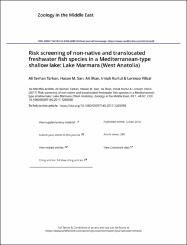Risk screening of non-native and translocated freshwater fish species in a Mediterranean-type shallow lake: Lake Marmara (West Anatolia)
Abstract
Risk screening tools to identify species with a high or low risk of invasiveness are being increasingly used for effective management purposes. Amongst the available tools, the Fish Invasiveness Screening Kit (FISK) has been used extensively and successfully in large risk assessment (RA) areas, and was recently upgraded to the new generic tool Aquatic Species Invasiveness Screening Kit (AS-ISK). The aim of the present study was to assess with AS-ISK the invasive potential of introduced nonnative and translocated fishes in a Mediterranean-type shallow lake (Lake Marmara) located in west Anatolia (Turkey). Based on independent evaluations of 35 species by two assessors, calibration of AS-ISK resulted in a threshold score of -3.65, which reliably distinguished between potentially invasive (high risk) and potentially noninvasive (medium to low risk) fishes. Of the 35 species assessed, 17 were categorised as 'low risk' and included native/endemic and translocated natives, and the remaining 18 as 'high risk' and comprised non-natives and translocated natives. Carassius gibelio had the highest score in the Climate Change Assessment section, suggesting that it might potentially impact on the native fish fauna under likely climate change scenarios for the RA area. Some cool water non-native (Oncorhynchus mykiss, Salvelinus fontinalis), translocated native (Luciobarbus lydianus) and endemic species (Ladigesocypris mermere) in the catchment will likely be affected negatively by predicted climate change conditions.


















